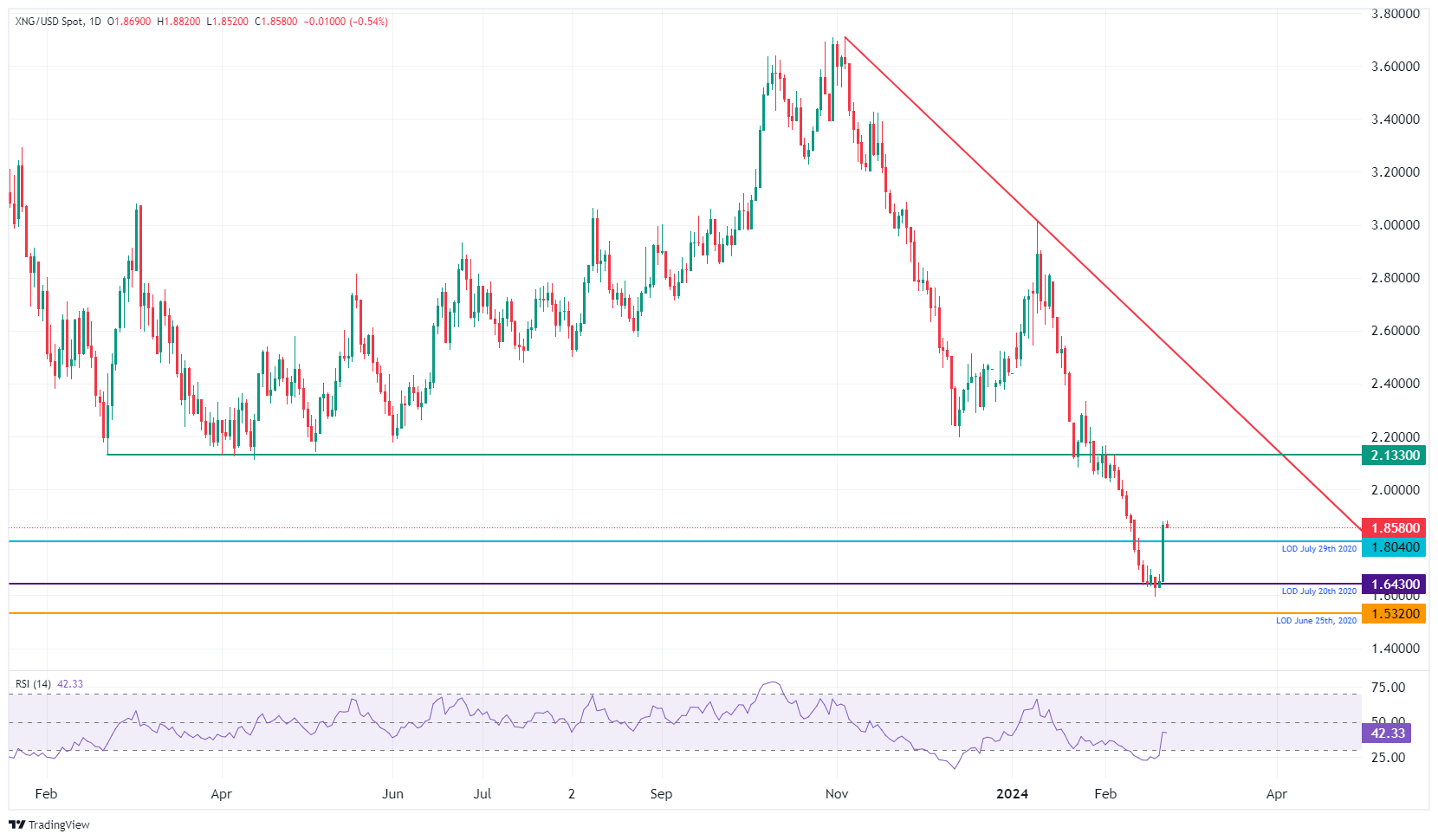- The price of Natural Gas gives up a little after its intraday recovery of 12% on Wednesday.
- Investors see upside potential in Gas prices as supply issues mount.
- DXY Dollar Index falls below 104.00 as market sentiment improves.
The price of Natural Gas (XNG/USD) remains above $1.80 on Thursday, after registering gains of more than 12% on Wednesday. The price rise is driven by rising geopolitical tensions in the Middle East and increasing supply issues. Iran's Oil Minister Javad Owji accused Israel of sabotaging its main gas pipeline and blamed the country for a series of attacks targeting Iran's nuclear program. On the supply side, Chesapeake Energy reported that it will reduce its Natural Gas production by 20%, while Norwegian and US exports of Liquefied Natural Gas (LNG) stagnate or fall substantially.
The US Dollar (USD) faces a sharp decline even as geopolitical tensions continue to rise, with the US Dollar Index DXY falling below 104.00 following a wave of risk appetite following the release of upbeat earnings of Nvidia and that the Fed minutes did not give any surprises.
Natural Gas is trading at $1.86 per MMBtu at the time of writing these lines.
Movements in the Natural Gas market: Supply is reduced even further
- Global Gas supply has just been reduced, with Chesapeake reducing its production by 2024. The energy company will reduce about 20% of its total production by 2024.
- An unforeseen interruption in Norway has continued until Friday on its main gas pipeline to Europe.
- An important Liquefied Natural Gas terminal in Italy begins maintenance eight months ahead of schedule.
- The US, Europe's main gas supplier, reports that an LNG export plant near Sabine Pass will remain closed for the rest of the week.
Natural Gas Technical Analysis: It is time for operators to keep levels stable
The price of Natural Gas had a field day on Wednesday with its sharp increase of 12%. Now is the time for investors to hold current levels if they want the price to continue rising. The reduction in supply could help Natural Gas prices return to $2.
On the upside, Natural Gas faces some fundamental technical levels. The next stop is at $1.99, the level that, when broken, witnessed an accelerated decline. After that, the green line at $2.13 is in sight, with the 2023 triple bottom. If Natural Gas experiences a sudden spike in demand, $2.40 could come into play.
On the downside, $1.80 is key support, as it was a pivotal level in July 2020. If the recent headlines begin to fade, or more supply emerges in the markets of other companies or countries to fill the gaps, the $1.64 and $1.53 (the 2020 low) are targets to keep in mind.
XNG/USD daily chart
Frequently asked questions about Natural Gas
What fundamental factors determine the price of Natural Gas?
The dynamics of supply and demand is a key factor that influences Natural Gas prices, and is in turn influenced by global economic growth, industrial activity, population growth, production levels and inventories. Climate influences Natural Gas prices because more Gas is used during cold winters and hot summers for heating and cooling. Competition from other energy sources influences prices as consumers may opt for cheaper sources. Geopolitical events, such as the war in Ukraine, also play a role. Government policies related to extraction, transportation and environmental issues also influence prices.
What are the main macroeconomic publications that influence Natural Gas Prices?
The main economic publication that influences Natural Gas prices is the weekly inventory bulletin of the Energy Information Administration (EIA), a US government agency that produces data on the gas market in the United States. The EIA Gas bulletin usually comes out on Thursday at 14:30 GMT, the day after the EIA publishes its weekly Oil bulletin. The economic data of the large consumers of Natural Gas can influence supply and demand, among which China, Germany and Japan stand out. Natural gas is primarily priced and traded in US dollars, so economic releases affecting the US dollar are also factors.
How does the dollar influence Natural Gas prices?
The US dollar is the world's reserve currency and most commodities, including Natural Gas, are quoted and traded in international markets in US dollars. Therefore, the value of the Dollar influences the price of Natural Gas, since if the Dollar strengthens, fewer dollars are needed to buy the same volume of gas (the price falls), and vice versa if the dollar strengthens.
Source: Fx Street
I am Joshua Winder, a senior-level journalist and editor at World Stock Market. I specialize in covering news related to the stock market and economic trends. With more than 8 years of experience in this field, I have become an expert in financial reporting.








